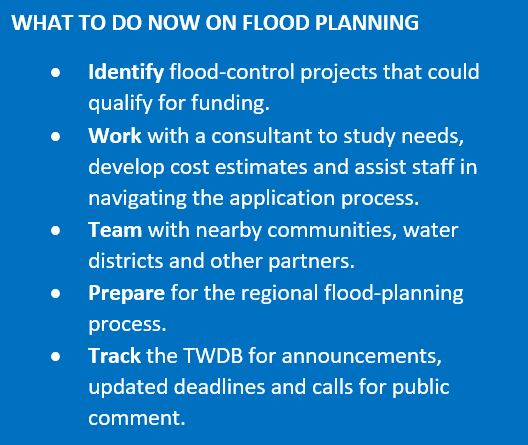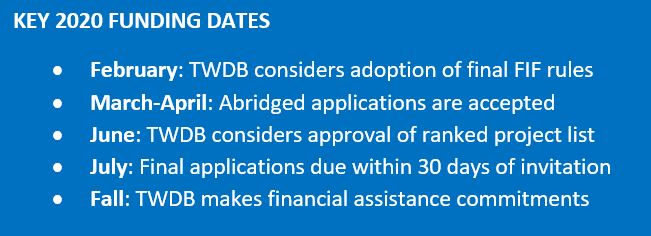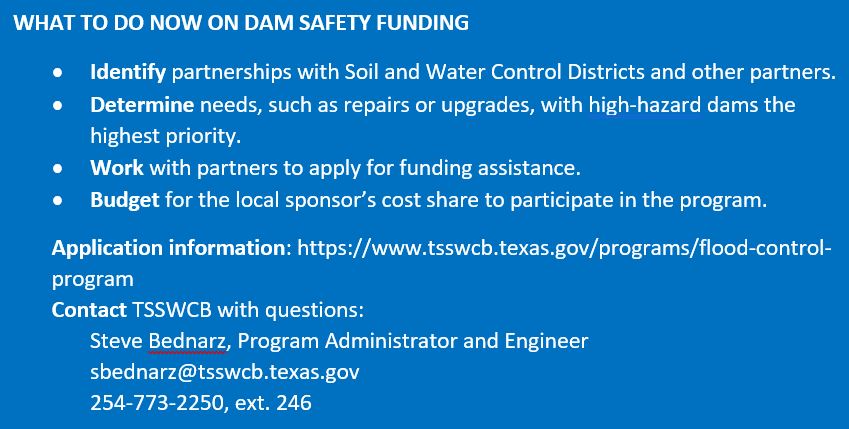How to Get Involved on Texas Flood Planning
The constitutional amendments that voters approved in November 2019 resulted from new planning and funding laws passed by the Texas Legislature. Now, the Texas Water Development Board (TWDB) is overseeing two key expansions to flood-related programs:
The Flood Infrastructure Fund (FIF) will provide grants and low-cost loans for public projects to improve drainage, flood control and flood mitigation. The deadline for public comment on eligibility rules is Jan. 13. Comments can be sent to rulescomments@twdb.texas.gov. or to Flood-IUP-Comments@twdb.texas.gov for the Flood Intended Use Plan that will be issued for each funding cycle.
The Texas Infrastructure Resiliency Fund (TIRF) will fund projects related to Hurricane Harvey and support development of a comprehensive, long-range State Flood Plan.

These developments can help cities and counties, especially those with projects on the drawing board. Here’s what decisionmakers need to know:
The Flood Infrastructure Fund
The FIF is being funded initially with $793 million from the state’s Economic Stabilization Fund, otherwise known as the Rainy Day Fund. The idea is to help with cost-effective solutions, particularly for counties and communities that otherwise could not afford repairs or mitigation infrastructure.
The TWDB expects to finalize the FIF eligibility rules in February, and applications for the first round of funding will be due in April. The board will ask for more-detailed applications for the higher-ranked proposals, with funding allocated later in 2020.
Financial assistance will be available for projects that are structural (levees, floodwalls, retention basins) and nonstructural (wetlands restoration, warning systems, hydraulic/hydrologic studies). To be eligible, projects must involve collaboration among neighboring cities, counties, river authorities and other related districts to make sure that improvements are coordinated and don’t harm others.
Once the State Flood Plan takes effect in 2024, the FIF will only fund projects included in the plan. That means entities interested in FIF grants or loans should be involved in their region’s flood planning and get their projects incorporated into the regional plans.
The State Flood Plan
For most communities, the Texas Infrastructure Resiliency Fund’s most important element is the flood-planning process, which will be modeled after the State Water Plan and its approach to state and regional water-supply planning.

The first State Flood Plan is due in 2024 and will be updated every five years. It will include these components:
- An evaluation of existing flood infrastructure across Texas
- A statewide ranked list of ongoing and proposed flood-control projects and strategies
- An analysis of development in the 100-year floodplain, as defined by the Federal Emergency Management Agency
- Recommended legislative policy changes to improve planning and fund project completion
Texas has long needed a comprehensive way of helping cities and counties recover from floods and protect against future risks. Hurricane Harvey convinced lawmakers to fortify communities against another flood-related disaster.
Local officials and their partners have an historic opportunity to improve their regional infrastructure.
Dam Safety Supplemental Funding
Along with the TWDB, the Texas State Soil and Water Conservation Board (TSSWCB) has been tasked by the Texas Legislature with incorporating earthen dams into the larger picture for flood mitigation strategies and developing a 10-year plan to bring all high-hazard dams up to safety standards.
More than 2,000 dams in Texas were built by the Natural Resources Conservation Service and are operated and maintained by local entities. The Texas Commission on Environmental Quality considers approximately 600 of these dams “high hazard,” but only 123 meet current dam safety criteria. More than $1.5 billion in needs have been identified to rehabilitate/upgrade the remaining high-hazard dams.
The Legislature in 2019 appropriated an additional $150 million for dam repairs and upgrades, which TSSWCB will administer through grants to local sponsors of flood-control dams. In some cases, the TSSWCB may fund up to 95% of project costs, with local sponsors covering the remaining 5%.
The TSSWCB has designated projects for 2020 that are in the planning, design or construction phases using the supplemental funding. View a list: https://www.tsswcb.texas.gov/flood-control-repair-projects




